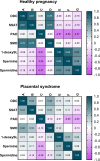The role of 1-Deoxysphingolipids and Polyamines in the pathogenesis of placental syndrome
- PMID: 39844083
- PMCID: PMC11753022
- DOI: 10.1186/s12884-025-07175-1
The role of 1-Deoxysphingolipids and Polyamines in the pathogenesis of placental syndrome
Abstract
Background: Placental syndrome, mainly composed of preeclampsia and fetal growth restriction, has an impact on the health of mother and baby dyads. While impaired placentation is central to their pathophysiology, the underlying molecular mechanisms remain incompletely understood. This study investigates the association between placental syndrome and metabolic alterations in 1-deoxysphingolipids (1-deoxySLs) and polyamines, along with their regulatory enzymes.
Methods: This prospective case-control study involved 26 healthy pregnant women and 17 with placental syndrome. Blood samples were collected from maternal, uterine venous, and umbilical cord veins. Levels of 1-deoxySL, spermine, and spermidine, as well as related enzymes of polyamine metabolism such as ornithine decarboxylase (ODC), spermidine/spermine N1-acetyltransferase (SSAT), polyamine oxidase (PAO), and spermine oxidase (SMO), were measured using the techniques of LC-MS and ELISA, respectively.
Results: Women with placental syndrome had significantly higher levels of 1-deoxySL, spermine, and spermidine in all blood samples compared to the healthy pregnancy group. Additionally, ODC and SSAT levels were reduced significantly in the placental syndrome group, while PAO and SMO levels showed no significant differences. Strong positive correlations were found between the studied enzymes and biomolecules in healthy pregnancies, which were notably weaker in the placental syndrome group.
Conclusion: This study demonstrates significantly altered levels of 1-deoxySL and polyamines, with corresponding enzyme activity changes, in placental syndrome compared to healthy pregnancies. The disrupted correlations between these biomolecules suggest alterations in their metabolic pathways and potential utility as biomarkers. Further mechanistic studies are warranted to elucidate their role in placental syndrome pathophysiology.
Keywords: 1-deoxysphingolipids; Fetal growth restriction; Placental syndrome; Polyamines; Preeclampsia.
© 2025. The Author(s).
Conflict of interest statement
Declarations. Ethics approval and consent to participate: The study was conducted according to the guidelines of the Declaration of Helsinki, and approved by the Ethical Committee of the Haseki Training and Research Hospital. In addition, before conducting the surveys, the informed consent was obtained from all study participants by the researchers. Disclosure statement: During the preparation of this work, the authors used AI-assisted technologies (QuillBot AI) in order to improve readability and language. After using this tool, the authors reviewed and edited the content as needed and take full responsibility for the content of the publication. Consent for publication: Not applicable. Competing interests: The authors declare no competing interests. Clinical trial number: Not applicable.
Figures

Similar articles
-
Polyamine synthesis from proline in the developing porcine placenta.Biol Reprod. 2005 Apr;72(4):842-50. doi: 10.1095/biolreprod.104.036293. Epub 2004 Dec 1. Biol Reprod. 2005. PMID: 15576824
-
Spermine oxidase SMO(PAOh1), Not N1-acetylpolyamine oxidase PAO, is the primary source of cytotoxic H2O2 in polyamine analogue-treated human breast cancer cell lines.J Biol Chem. 2005 Dec 2;280(48):39843-51. doi: 10.1074/jbc.M508177200. Epub 2005 Oct 5. J Biol Chem. 2005. PMID: 16207710
-
Hepatitis C virus alters metabolism of biogenic polyamines by affecting expression of key enzymes of their metabolism.Biochem Biophys Res Commun. 2017 Feb 5;483(2):904-909. doi: 10.1016/j.bbrc.2017.01.032. Epub 2017 Jan 9. Biochem Biophys Res Commun. 2017. PMID: 28082202
-
Polyamines in renal failure.Amino Acids. 2006 Nov;31(4):477-83. doi: 10.1007/s00726-006-0264-7. Epub 2006 Mar 24. Amino Acids. 2006. PMID: 16554974 Review.
-
Polyamine metabolism and cancer.J Cell Mol Med. 2003 Apr-Jun;7(2):113-26. doi: 10.1111/j.1582-4934.2003.tb00210.x. J Cell Mol Med. 2003. PMID: 12927050 Free PMC article. Review.
Cited by
-
Insights into the Global and Mexican Context of Placental-Derived Pregnancy Complications.Biomedicines. 2025 Mar 1;13(3):595. doi: 10.3390/biomedicines13030595. Biomedicines. 2025. PMID: 40149572 Free PMC article. Review.
References
MeSH terms
Substances
LinkOut - more resources
Full Text Sources
Research Materials
Miscellaneous

